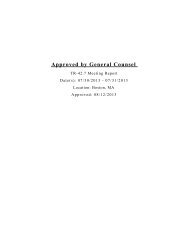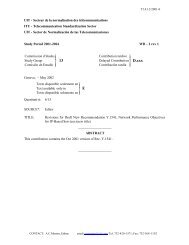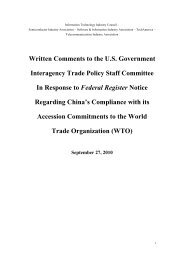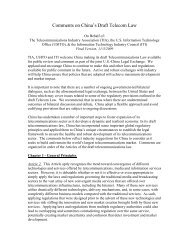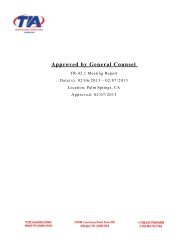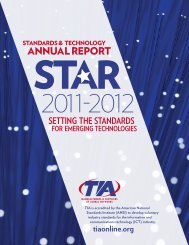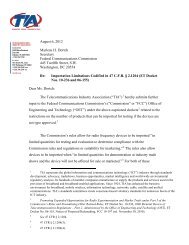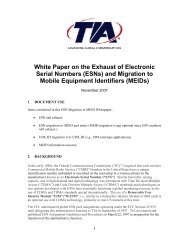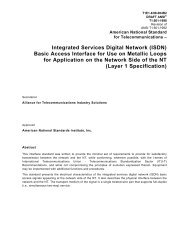ITU-T V.150.1
ITU-T V.150.1
ITU-T V.150.1
- No tags were found...
You also want an ePaper? Increase the reach of your titles
YUMPU automatically turns print PDFs into web optimized ePapers that Google loves.
12.2.1 Transport Channel selection for error controlled configurations<br />
For error controlled configurations the IP-TLP shall use a Reliable Sequenced Channel (RSC) (e.g.<br />
SPRT Channel 1) for both directions of packet transmission.<br />
12.2.2 Flow Control for error controlled configurations<br />
With an error-controlled link, full end-to-end flow control is present. The flow control for each of<br />
the separate error controlled links is independent of each other. Such data flow control may be<br />
performed using V.42 or IP-TLP (e.g. SPRT) procedures. For example, M1/G1 and G2/M2 modem<br />
pairs may flow off data from each other by transmitting V.42 RNR: G1 and G2 can flow off by<br />
using the window flow control mechanisms of the IP-TLP.<br />
12.3 Non-error controlled PSTN Links<br />
Connections occurring in one of the non-error controlled configurations may occur:<br />
• Due to an application requiring a synchronous data link, or<br />
• Be disabled to reduce link layer latencies (e.g. electronic gaming), or<br />
• The modems have failed to negotiate error control due to PSTN line conditions.<br />
If a modem fails to establish an error-controlled link, clause 7.9/V.42 defines that the fallback shall<br />
be to <strong>ITU</strong>-T Recommendation V.14. V.14 is based upon start-stop delimited data.<br />
12.3.1 Transport Channel Selection for non-error controlled links<br />
For the non-error controlled links the selection of the transport channel depends upon whether the<br />
links are symmetrically or asymmetrically non-error controlled.<br />
12.3.1.1 Symmetric No-EC Transport Channel Selection<br />
For the Symmetric No-EC connection, either RSC or an Unreliable Sequenced Channel (USC) (E.g.<br />
SPRT Channel 3) may be used for both of the transmission paths of the IP-TLP. The default<br />
Transport Channel in this configuration is USC.<br />
12.3.1.2 Asymmetric No-EC Transport Channel Selection<br />
There are independent options for each of the transmit directions for this hybrid mode of operation.<br />
For the No-EC to EC transmit direction both the RSC and USC may be used, with the default<br />
transport channel being USC. For the EC to No-EC transmit direction again both RSC and USC<br />
may be optionally chosen, however, in this case the default is RSC.<br />
12.3.2 Effective Data Signalling Rate Matching<br />
The relationship between the physical layer and the link layer for MoIP is very important. It is<br />
possible for there to be a mismatch in either modulation or data signalling rate between the two<br />
PSTN links. A mismatch in the data signalling rates as selected by the PSTN links requires certain<br />
considerations to minimize data loss. In general, modulations may be categorized as being either<br />
low-speed or high-speed modulations. For this Recommendation the term high-speed modulations<br />
refers to V.32/V.32 bis, V.34, V.90 etc. and low-speed modulations are V.22/V.22 bis, V.23, V.21<br />
etc. The general distinction used is that high-speed modulations provide mechanisms to change<br />
their data-signalling rate during a connection and low speed modulations do not. For MoIP this is<br />
an important characteristic.<br />
<strong>ITU</strong>-T Rec. <strong>V.150.1</strong> (01/2003) – Prepublished version 16



